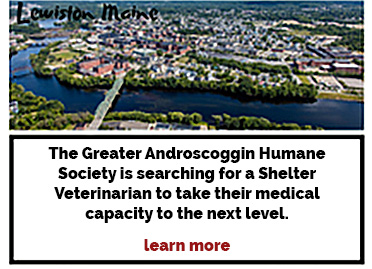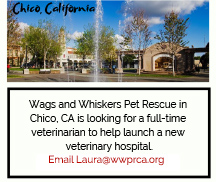ISSUE 1 // VOLUME 3 OR 4. BUT WHO’S COUNTING?
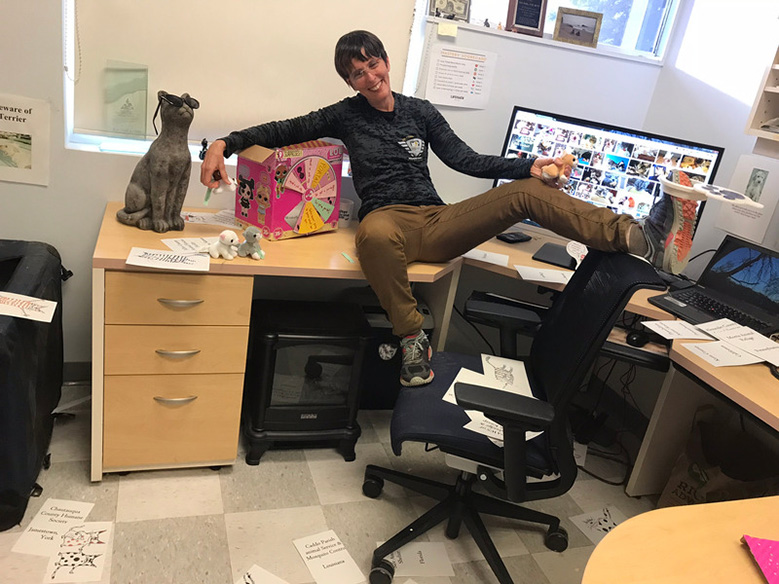
HELLO FROM THE OTHER SIDE
BY KATE HURLEY
Hello and welcome to the third, or possibly fourth, quasi-annual relaunch of The Shelter Medicine Times, bringing you “all the news that’s fit to sniff” on and off since about 2005!
What took so long, you might ask? Well, truthfully, part of the reason is that our small team has been a bit distracted by literally about a million things cats. Now that the amazing and dauntless million cat challengers – including many on this list – have cruised past that goalpost and moved on to #allthecats, we thought we’d unearth a few of our other projects.
But the main reason to relaunch the newsletter is really just that we missed you.
We love our work, we love sharing the things we learn, and we love hearing from you. In fact, we couldn’t be here without you, and we wouldn’t want to be!
The truth is, shelter medicine is still a very young specialty. Think about it: while there was certainly great work being done in the trenches prior, the Association of Shelter Veterinarians and the first academic shelter medicine program were both founded in 2001. If we were to take that as the official birth of Shelter Medicine, the field would just now be turning 18. If Shelter Medicine were a human teen, she’d probably be getting ready to pack her bags and head off to college (or knowing her, perhaps she’d spend a year or two in the Peace Corps or roaming the globe spaying and neutering the free roaming animals of the world first).
– continued page 3
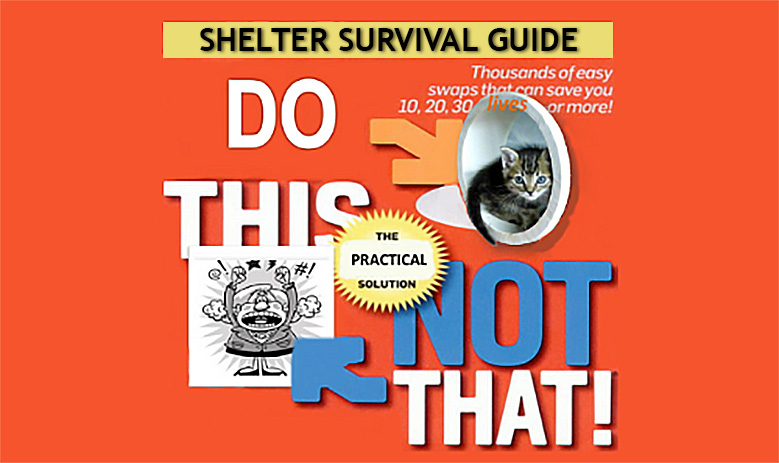
Do This, Don’t Do That
In this ongoing series we delve into the things we can let go of in order to make time for things that really pay off to keep shelter animals happy and healthy.
Do: House cats in multiple compartment housing units and use spot cleaning.
Don’t: Clean housing thoroughly and fully while cats are in residence.
What do these two have in common? The Don’t becomes so much easier when we do the Do.
Standard single space cage housing (the ol’ stainless steel 2×2 cage) does not meet cats’ basic needs to stretch out completely, to be able to eat without touching their litter box, to play, or even hold their tail erect in some cases.
Not having these basic needs met creates stress and we all know what means: unhappy cats, stress and activation of the latent herpes virus infection that causes feline upper respiratory infection (Read: longer stays, increasing care costs.)
And thus the creation of ‘the portal’ – a practical, low-cost solution to this common housing problem. By installing portals, shelters can instantly turn their shabby singles into deluxe doubles creating healthier, humane housing suites without the expense or hassle of purchasing new housing.
Do The Do…uble
Double compartment housing makes true spot cleaning possible.
– continued on page 3
b & t
Studies suggest a dog has 8 minutes to woo potential adopters. Do you know what two behaviors are the strongest determinants in adoption predictability? Take the quiz and find out. Maybe you’ll be our first Click Bait prizewinner!

WEBINAR WATCH
CATS, BIRDS, AND ANIMAL SHELTERS: SEEKING COMMON GROUND
How can animal welfare professionals balance their commitments to protect both birds and cats? In this recent webinar, Dr. Kate Hurley used data and real-world examples to explore the ethical and practical dimensions of this seeming conflict.
View the archived presentation


We hate keeping our crushes a secret, and we aren’t good at it anyway. Here are our top three loud and proud reasons we are completely smitten with Rescue® (formerly Accel) the cleaner and disinfectant combo. 1) It’s accelerated hydrogen peroxide. Unlike caustic chemicals tough enough to kill parvo (lookin’ at you, bleach), hydrogen peroxide is gentle on the environment, user and animals. The accelerated part means it’s stable (no need for that brown bottle and always keeping the cap on). 2) Rescue is odor neutral, which prevents nose blindness (think Fear Free). 3) Many people, even those that love Rescue, don’t know this final factoid… you don’t need to rinse Accel! Simply let it air dry.
* We weren’t paid- or even asked- to promote this product. We are just big ol’ fans.

… HELLO (CONT’D FROM P. 1)
And just like any human offspring, it takes a village to raise a specialty. Those of us working as consultants and educators have the privilege of witnessing the challenges, solutions and successes of those in the field. To then be able to combine that with the access to research and all the rich resources of academia is truly extraordinary. We hope this newsletter is one way we can spread the collective wisdom of the village we all call home. And we hope you’ll chime in with your ideas, questions, cat haikus and portal pics.
Email us any time at sheltermedicine@ucdavis.edu. And happy 18th birthday, shelter med!

…DO THIS, DON’T DO THAT (CONT’D FROM P. 2)
Not only do the housing units tend to stay cleaner when the cats have more space, but the ease of cleaning double compartment cages compared to single compartment cages is enormous. Not to mention the decreased risk of exposure of the cat to pathogens when the cat can be tucked safely on the other side of the cage, away from the person who is spot cleaning. Learn more about the benefits of spot cleaning, and even a sample protocol on how to do it.
HAIKU CORNER
Portal through my home
Have space in a scary place
Room to be myself
Post your portal-inspired (theme changes every newsletter) Haiku on the Koret Shelter Medicine Program Facebook page.
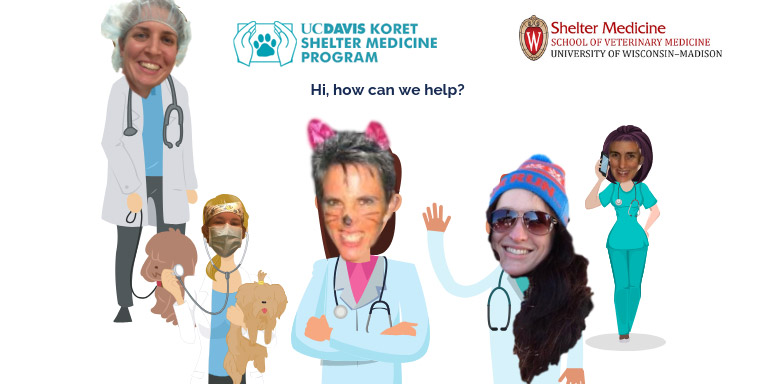
WE SHARE THE RESOURCES
BY ANDY PANTS COWITT
The most popular section of our website, sheltermedicine.com, is the Resource Library. Last December, of the over 22,000 pages viewed by visitors to our site, more than 19,000 were resources in the library. Maybe you found your way to this newsletter via the library, where you saw Guidebooks, Information Sheets, and FAQs written and revised anywhere from 2015 to just last week.
Internally, we refer to the library as the SRL (Shared Resource Library). That’s because we share the responsibility for keeping its contents up-to-date with our “sister program” at the University of Wisconsin-Madison School of Veterinary Medicine.
(This arrangement might be unusual but it’s hardly surprising: Dr. Sandra Newbury, Director of the University of Wisconsin Shelter Medicine Program, helped to build the KSMP from 2006-2014.)
Every resource in the Shared Resource Library was written by a member of either the KSMP or UWSMP team, and with just a few exceptions, appears on both sheltermedicine.com, the KSMP website, and on uwsheltermedicine.com, the University of Wisconsin Shelter Medicine Program website.
What The FAQ?
Have you ever had to solve a full-blown mite or ear infection problem without a way to quarantine? That’s the question Dr. Bridget Holck of the UW Shelter Medicine Program received via the sheltmedconsult@gmail.com mailbox last November.
Dr. Holck recommends selamectin as an effective treatment that is fairly easy to apply to difficult-to-handle cats and only requires reapplication every 30 days. To get more details on this FAQ or see others, visit the Resource Library on sheltermedicine.com.
PORTAL IT FORWARD
BY MANDY NEWKIRK
It was this exact time last year when Dr. Hurley formulated her master plan to portalize the world.
Inspired by the “Pay It Forward” movement, and Kate’s unwavering commitment to kindness, trust, and portals (that would be the name of her band), her strategic plan was really more of a gesture: Use the money she won from her Maddie’s Hero Award to buy $10,000 worth of portals and then give them away to shelters that need them.
She knew portals save money by lowering disease and shortening length of stay, and she figured
as soon as shelters start saving money, they’ll be inspired to “Portal It Forward” and help the next shelter with the upfront costs of taking the portal plunge. I’ll admit it, our team was a bit skeptical. As you might imagine, the concerns voiced were along the lines of, “That worked in Hollywood, but we probably can’t expect this to go any further than our initial investment.”
Word of advice: Don’t ever bet against kindness. The portal pleas poured in and before contest entrants were even drawn, the community stepped up and matched Kate’s initial investment making it possible for every single shelter that entered to win portals (over 40!) to transform their cat housing. (Could you say no to these faces?) It was a campaign we’ll never forget and one that has paid us back with joy and photos of luxuriously stretched cats all year long, but so far it’s still too early for shelters to have had the opportunity to Portal It Forward. That is, until this email landed in our boxes in early November delivering best holiday gift we could’ve ever asked for:
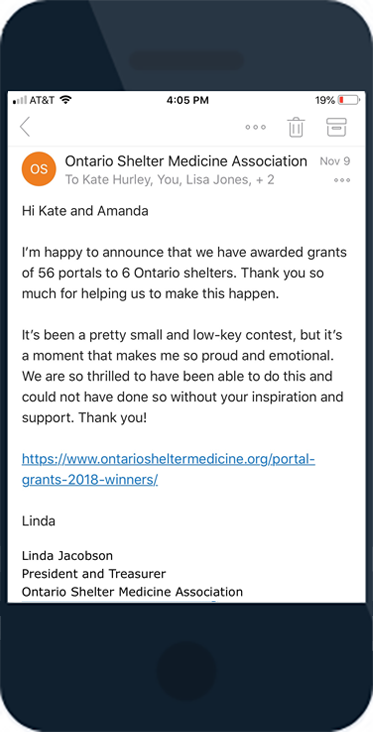
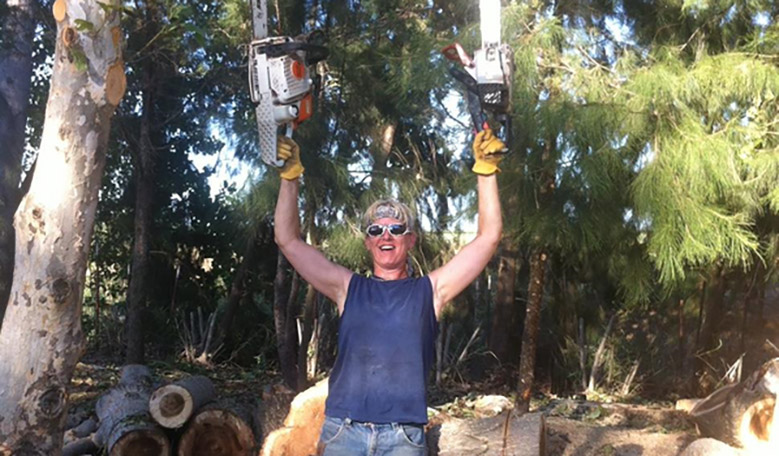
DR. WAGNER IS NOT F*ING AROUND
BY MANDY NEWKIRK
If you’re lucky, you have a friend like Denae Wagner in your circle. The one that doesn’t say much but drops occasional gems from left field that cut right to the point (yes, she played softball a lot back in the day – same location). Denae’s no-nonsense, “Keep It Simple ” approach is as wellintentioned as it is informed.
Which is probably why our favorite Midwesterner is always flooded with housing and facility design questions in our shelter medicine inbox, especially this time of year (Portal Season). If you’ve got a minute, grab your favorite drink and pull up a chair. Let’s get to know the Portal Queen a little better.
Denae, where does your passion for humane housing come from?
My passion for housing has grown from my experience in population health working with farm animals, where housing and the environment play critical roles in animal health and well-being.
Also, my love of design and building things. (I built my first chicken coop when I was 10 – Dad helped.) Good housing supports health. It just makes sense to me.
Most animals only stay in the shelter for a relatively short period of time, why spend so much time/resources working on housing when you could use those resources to take in one more animal?
Most shelter animals are housed in compact spaces (cages or kennels) nearly 24/7. This type of housing falls in one of two camps – either it meets an animal’s needs and supports health and well-being, or it doesn’t. If housing allows the animals to be comfortable and feel safe and have their basic needs met (bed, food, water, separate place for elimination, good lighting, proper temperature/humidity and good quality air), everything else we do for them will build on that. On the flip side, housing that doesn’t meet an animal’s basic needs, perhaps they don’t feel safe, aren’t comfortable, too cramped, aren’t able to express behaviors, have little to no choice… then these factors take precedence and all the other good things we try to do really become second fiddle to the larger stress of poor housing. Does that mean if we have poor housing we should give up? Absolutely not!
Continue to do all the good things you can do to mitigate the problem, but also identify housing limitations and plan to ultimately resolve them if those units will stay in use, or slot them for uses that are more appropriate, like shelving for towels. In the meantime, shorten the length of stay (LOS) as much as
possible in housing that is simply not supportive of animal well-being and get some portals or a jack hammer or whatever is needed to provide healthy housing. Once it’s fixed it will work continuously to support your work without too much more attention. It’s a good fix that lasts a long time.
What would you tell a shelter that wants to improve their housing but doesn’t have budget to do too much. How can they get the biggest bang for their buck?
If it’s single cage housing for cats, small dogs, puppies or rabbits, then install portals to make double compartment cage housing. Portals don’t cost that much, and they have a transformative effect. Not only for the animals, but for the facility as a whole. Animals are happier and healthier in double compartment cages vs singles and this housing type provides staff with the ability to take very good care of a wide variety of animals.
What is your best piece of advice for a shelter that is ready to undertake an entire shelter renovation?
Put some effort into determining your ideal housing capacity, which we sometimes call your “magic number”. Lots of folks think with a new renovation or new building that just adding some more housing to the housing numbers they already have is the way to go. But that’s often not the case. Right sizing your housing numbers is the key and it’s based on animal intakes, expected averages for LOS and the rest is math. We have resources on how to calculate your right-sized housing needs on our website (just type magic number into the search box). The cool thing is that the right number of housing units is one of the key elements of the Capacity for Care (C4C) management model,
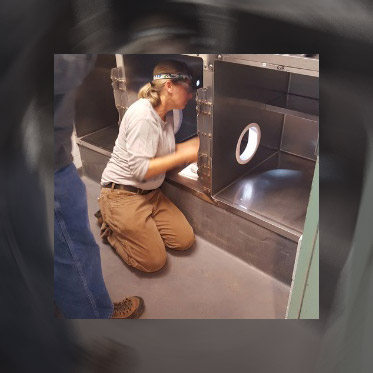
so getting C4C up and running in the existing facility will give you a very good idea of what your housing needs actually will be – and they’re often less than expected. This gives you a great place from which to start your planning, whether that new facility or renovation is on next year’s docket or down the road a bit.
It seems like cat cage housing has been identified as an area of great need in shelters. What are we talking about for fixing this?
With existing housing, it means giving each shelter-housed cat at least two, 2 x 2 cages joined together to create one double compartment suite with a pass through. Obviously I’m thinking of a portal here, but I’m happy with whatever you can come up with that allows the cat to have access to both cage sides. Heck, a 6” NEW sewer pipe works, folks. Portals look better and have a door, but if resources are strapped you can get creative.
We also have instructions on how to make portals out of 8” PVC pipe on our website, which are indestructible. Whatever it takes to get there.
Cage set up is important, too, but getting pass-throughs in makes the rest pretty easy. Add an elevated bed and attach the food and water dishes to the door (saves floor space) in the main living side and put a decent sized litter box on the other side. Add some bedding on top of the raised bed and/or under it, hang a towel off the bed for a hiding spot behind, add a partial cage cover to provide more hiding and visual choice and voilà! Good basic housing for most shelter cats. P.S. Stay away from the tiny double stacked cubbies, “triple compartment” units. The cubbies are often shown adjacent to a 2×2 or slightly bigger cage. The cubbies are sold as having a place for the cat to hide, a litter compartment and a main living area. They may look/sound good, and some folks make these work, but those cubbies are problematic. They are a bear to clean and don’t contain enough height above the litter box area for the cat to normally posture to eliminate.
Double cages provide the space needed to keep cats (and puppies, small dogs, rabbits…) healthy for a normal length of stay (about 7-10 days).
If you could wave a wand and change one thing about animal sheltering, what would it be?
Big picture? I wish we lived in a society that didn’t need animal shelters. But we aren’t quite there yet. Well… I’d be quite happy if all the 2×2 cages out there were portalized – big smile there.
What’s the coolest thing you’ve seen lately?
An all electric pickup truck with a tow capacity of 11,000 lbs.
I mean in the animal sheltering world.
Which is part of the larger world, so I’m sticking to my answer. This thing was pretty slick.
Alrighty then, I’ll have to check that out.

Download a printable PDF version (opens in new tab): KSMP_Newsletter_Feb_2019-1.pdf




